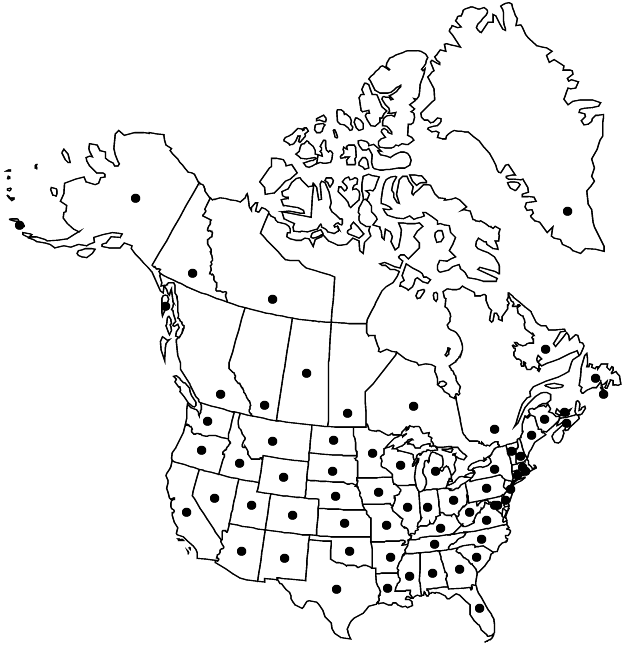Cerastium fontanum
Enum. Stirp. Transsilv. 1: 425. 1816.
Plants perennial (rarely annual), tufted to mat-forming, often rhizomatous. Stems: flowering stems erect from decumbent base, branched proximally, 10–45 cm, softly pubescent, eglandular with straight hairs; nonflowering shoots, when present, produced proximally, decumbent, rooting at nodes, branched, 5–20 cm, often subglabrous with alternating lines of eglandular hairs; small axillary tufts of leaves usually absent. Leaves not marcescent; blade 10–25(–40) × 3–8(–12) mm, densely covered with patent to ascending, colorless, long, eglandular hairs; leaves of flowering shoots in distant pairs, sessile, blade elliptic to ovate-oblong, apex subacute; leaves of sterile shoots pseudopetiolate, often spatulate, blade oblanceolate, apex obtuse. Inflorescences lax, 3–50-flowered cymes; bracts lanceolate, reduced, herbaceous, eglandular-pubescent, distal often with narrow, scarious margins. Pedicels somewhat curved distally, 2–10(–20) mm, longer than sepals, densely pubescent with patent, eglandular, rarely glandular hairs. Flowers: sepals ovate-lanceolate, 5–7 mm, margins narrow, apex acute, scarious, pubescent with eglandular, rarely glandular, hairs; petals oblanceolate, 1–1.5 times as long as sepals, apex deeply 2-fid; stamens 10, occasionally 5; styles 5. Capsules narrowly cylindric, curved, 9–17 mm, ca. 2 times sepals; teeth 10, erect, margins convolute. Seeds reddish brown, 0.4–1.2 mm, bluntly tuberculate; testa not inflated, tightly enclosing seed. 2n = 122–152, usually 144.
Distribution

Alta., B.C., Man., N.B., N.S., N.W.T., Ont., P.E.I., Que., Sask., Yukon, Ala., Alaska, Ariz., Ark., Calif., Colo., Conn., D.C., Del., Fla., Ga., Idaho, Ill., Ind., Iowa, Kans., Ky., La., Maine, Mass., Md., Mich., Minn., Miss., Mo., Mont., N.C., N.Dak., N.H., N.J., N.Mex., N.Y., Nebr., Nev., Ohio, Okla., Oreg., Pa., R.I., S.C., S.Dak., Tenn., Tex., Utah, Va., Vt., W.Va., Wash., Wis., Wyo., Europe, introduced elsewhere.
Discussion
Subspecies 4 (2 in the flora).
Cerastium fontanum is a highly variable and complex species. It often has been reported as C. vulgatum Linnaeus, an ambiguous name; see discussion under the genus.
Selected References
None.
Key
| 1 | Inflorescences never glandular; petals 1.3-1.5 times as long as sepals; capsules 11-17 mm; seeds 0.9-1.2 mm | Cerastium fontanum subsp. fontanum |
| 1 | Inflorescences occasionally viscid-glandular; petals equaling sepals; capsules 9-13 mm; seeds 0.4-0.9 mm | Cerastium fontanum subsp. vulgare |